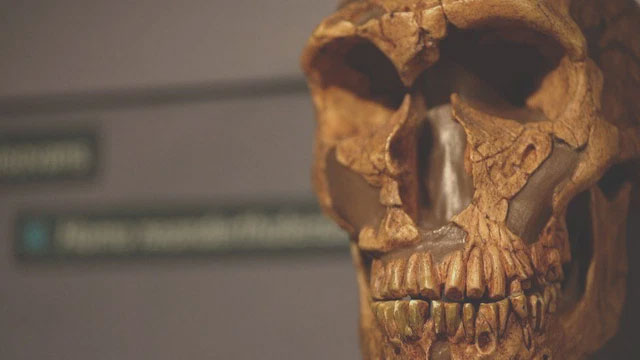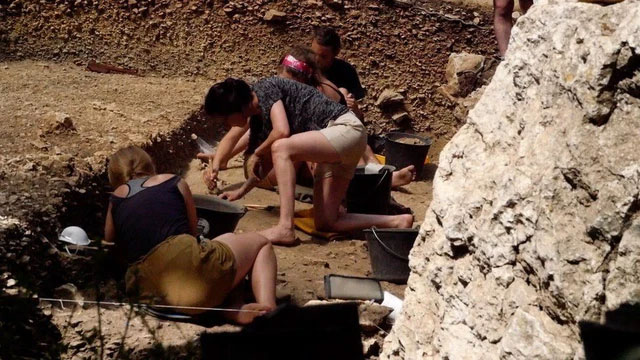The extinction of the Neanderthals was not caused by our ancestors overnight!
A discovery of a child's teeth and stone tools in a cave in southern France suggests that Homo sapiens was in Western Europe about 54,000 years ago.
This fossil suggests that our ancestors appeared here several thousand years earlier than previously thought, and it also suggests that Homo sapiens and Neanderthal species may have coexisted at one time. long time.

The Neanderthals were a distinct human species that inhabited Europe for hundreds of thousands of years until their extinction 40,000 years ago.
This new study has been published in the journal Science Advances.
These fossils were discovered in the Grotte Mandrin cave in the Rhone Valley, by a research team led by Professor Ludovic Slimak of the University of Toulouse. He was surprised to learn that there was evidence of early modern human settlement.
"We can now show that Homo sapiens appeared here 12,000 years earlier than we expected, but this population was later superseded by other Neanderthal populations. And this really forces us to take a different look at human history."

Archaeologists have discovered modern human remains at the Grotte Mandrin cave dating back to 54,000 years ago, thousands of years earlier than previously thought.
Neanderthals appeared in Europe 400,000 years ago. The current theory holds that they went extinct about 40,000 years ago, not long after Homo sapiens left the African continent.
However, the new discovery shows that our species appeared in Europe much earlier and that the two species may have coexisted in Europe for more than 10,000 years before the Neanderthals went extinct.
According to Professor Chris Stringer, of the Natural History Museum in London, this new archaeological find challenges the current view - our species quickly overpowered Neanderthals.
"It's not an overnight takeover by modern humans," he said. "Sometimes Neanderthals have the edge, sometimes modern humans have an advantage, so this competition is fair and square." going on for a longer time than we think."
Archaeologists have found fossil evidence from many geological layers in this area. The deeper archaeologists dig, the farther we can see. The deepest layers show remains of the Neanderthals who occupied the area for about 20,000 years.
To this brand new surprise, the team found the tooth of a modern child in a class dating to about 54,000 years ago, along with a number of stone tools made in an unusual way. related to the Neanderthals.
Evidence suggests that the early group of Homo sapiens lived at the site for a relatively short period of time, perhaps about 2,000 years after the site was uninhabited. Accordingly, the Neanderthals returned, occupying the site for another few thousand years, until modern humans returned about 44,000 years ago.

The tools were found with the child's teeth. There is speculation that the smallest specimens may be arrowheads.
Professor Stringer said: "Modern humans appeared for a short time, then there was a gap that could have been caused by climate, which made it impossible for our ancestors to adapt and then humans. Neanderthals are back".
Another important finding was the association of stone tools found in the same sediments with the teeth of a modern human child. Tools made in a similar way have been found in several other locations - in the Rhone valley and also in Lebanon, but so far scientists are not sure which human species made them.

This child's tooth fragment may have changed the story of the emergence of modern humans.
Some researchers speculate that some of the small-sized tools found could be arrowheads. If confirmed, it would be quite an exciting discovery: an early group of modern humans used advanced weapons including bows and arrows to outmaneuver the Neanderthals 54,000 years ago. But if that's the case, it's only a temporary advantage.
So if it wasn't for our species to wipe them out immediately, what gave us the edge?
Many ideas have been put forward by scientists: our ability to create art, language, and possibly our own superior brain. But Professor Stringer believes it comes from our ancestors living and operating in a more organized way.
"We have more connectivity between individuals, our social groups are larger, Homo sapiens have better knowledge storage and our social organization is built on on that knowledge," he said.
According to Professor Stringer, the idea of a prolonged interaction with Neanderthals is consistent with the finding made in 2010 that modern humans have a small amount of Neanderthal DNA, which suggests that the two species were hybrid.
- New discovery of the extinction of the Neanderthals
- Are Neanderthals extinct because their eyes are too big?
- Human ancestors caused the extinction of animals 4 million years ago
- New discovery of the end of Neanderthals
- People have eaten Neanderthal relatives?
- The extinction of the Neanderthals
- Hard to believe in a land where one-third of women carry other human genes
- A common childhood disease can cause Neanderthals to become extinct
- Humans carry the genes of Neanderthals?
- Looking for the solution to the disappearance of the ancient Neanderthal
- Another human being became extinct because of the 'marriage of death' with our ancestors
- Why are Neanderthals soon extinct?
 Biography of hero Vu A Dinh
Biography of hero Vu A Dinh History of hematology
History of hematology Who is Mr. Tam Da 'Phuc-Loc-Tho' and what does it mean?
Who is Mr. Tam Da 'Phuc-Loc-Tho' and what does it mean? Unbelievable facts about the history of the oil and gas industry: Gasoline used to be cheaper than water, so abundant that it had to be dumped into the river...
Unbelievable facts about the history of the oil and gas industry: Gasoline used to be cheaper than water, so abundant that it had to be dumped into the river...